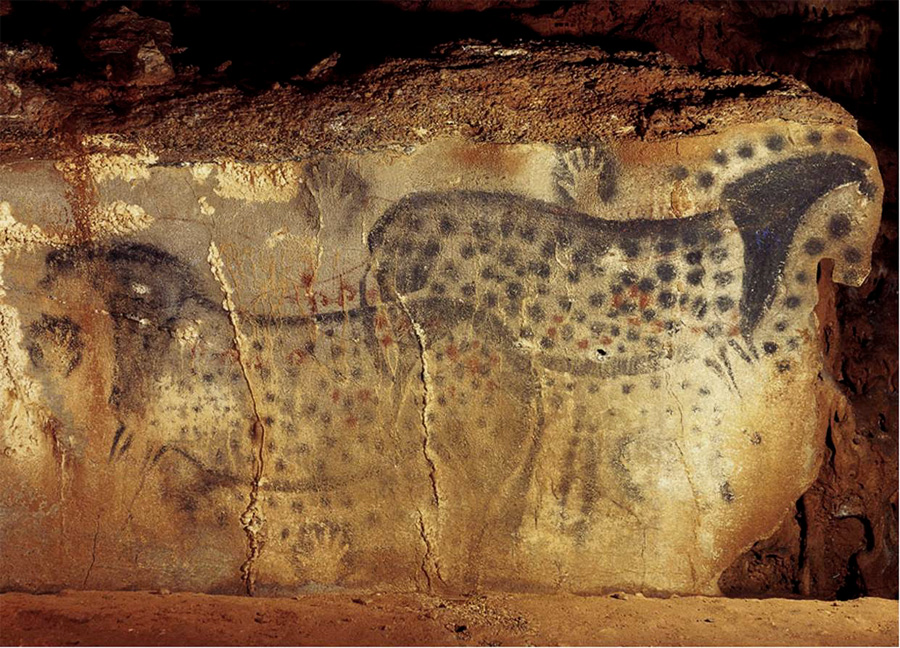



Photograph: Centre for Prehistory of Pech Merle/P Cabrol/AP
Extract taken from the article by Jonathan Jones, Guardian, 'Cave art: what DNA can't tell us about the spotty horses', November 2011.
In the painted cave of Pech Merle near Cahors in France, two horses seem to float on a stone panel - a natural wall of rock that stands more or less vertical. It offered the artists who worked here in the ice age a unique opportunity to create the equivalent of a Renaissance fresco on a mostly flat surface, unlike the bulbous outcrops where they painted other images. On this wall about 25,000 years ago, they painted a haunting vision of two calm and dreamlike equine spirits. The painted head of one horse seems to be shaped around an outcrop of the stone, creating a striking effect, as if the horses have materialised out of the natural rock. Most memorably, both creatures are covered in black dots created - like other abstract dots found in ice age cave art - by blowing pigment at the wall.
Now researchers at York and Berlin universities have published a paper about the horses. Their analysis of palaeolithic horse DNA seems to show that horses with white bodies and black spots actually existed in the Ice Age. So the painting at Pech Merle, one of the oldest and more famous of all known cave paintings, does not depict fantasy animals, but real horses observed from life.
That does not surprise me. When I was lucky enough to see those paintings up close, I was overwhelmed by the power of natural observation in them and other works there. Also in the cave is a vivid portrait of a mammoth. It's incredibly strange and moving: you are looking at an extinct animal painted from life. The new research claims to show the dream horses of Pech Merle are just as realistic as these mammoths.
If you follow debates about cave painting and its meanings, this might seem a very significant discovery. Decades ago, anthropologists used to believe cave art was a kind of "hunting magic". Today, that explanation is no longer fashionable. Instead, the most vivid contemporary theory holds that prehistoric painters may have been enacting shamanic rituals, and painting in a trance. According to this theory, the animals they painted are really animal spirits, encountered on visionary journeys through the dark underworld of the cave and the human mind.
The discovery that real-life ancient horses looked like the ones at Pech Merle might be taken as evidence against this theory, proof that far from going into a trance and documenting their dream journeys, the artists just painted what they saw. But I would say look again at the woolly mammoth in Pech Merle. It is a beautifully observed portrait. But it is something more. You can't see the mammoth's eye: its tusks merge into the sweeping, violent fall of boldly drawn lines that create its fur. It is monstrous and massive, not just a prosaic record of what a mammoth looked like but an expressive, imaginative response to the power of the animal, and what it was like to see it and fear it. The mammoth at Pech Merle, as we know from comparing it with preserved mammoths, is both an act of observation and an imaginative vision.
I would therefore argue that finding spotty horse DNA does not "explain" the painted horses of the ice age as works of art. Cave art is the birth of the human mind as we know it: the first known evidence of human beings thinking, feeling and creating in ways similar to modern people. It is where science begins, in the close observation of nature. It is also where art, religion and mythology begin. Real or unreal, the horses of the ice age show us our origins.
by Bradshaw Foundation
Monday 30 May 2022
by Bradshaw Foundation
Wednesday 19 January 2022
by Bradshaw Foundation
Thursday 06 January 2022
by Bradshaw Foundation
Monday 06 December 2021
by Bradshaw Foundation
Monday 29 November 2021
by Bradshaw Foundation
Monday 25 October 2021
by Bradshaw Foundation
Monday 12 July 2021
by Bradshaw Foundation
Monday 24 May 2021
by Bradshaw Foundation
Tuesday 20 April 2021
by Bradshaw Foundation
Thursday 01 April 2021
by Bradshaw Foundation
Tuesday 23 February 2021
by Bradshaw Foundation
Thursday 14 January 2021
by Bradshaw Foundation
Friday 18 December 2020
by Bradshaw Foundation
Sunday 06 December 2020
by Bradshaw Foundation
Thursday 26 November 2020
by Bradshaw Foundation
Wednesday 07 October 2020
by Bradshaw Foundation
Monday 30 May 2022
by Bradshaw Foundation
Wednesday 19 January 2022
by Bradshaw Foundation
Thursday 06 January 2022
by Bradshaw Foundation
Monday 06 December 2021
by Bradshaw Foundation
Monday 29 November 2021
by Bradshaw Foundation
Monday 25 October 2021
by Bradshaw Foundation
Monday 12 July 2021
by Bradshaw Foundation
Monday 24 May 2021
by Bradshaw Foundation
Tuesday 20 April 2021
by Bradshaw Foundation
Thursday 01 April 2021
by Bradshaw Foundation
Tuesday 23 February 2021
by Bradshaw Foundation
Thursday 14 January 2021
by Bradshaw Foundation
Friday 18 December 2020
by Bradshaw Foundation
Sunday 06 December 2020
by Bradshaw Foundation
Thursday 26 November 2020
by Bradshaw Foundation
Wednesday 07 October 2020
Friend of the Foundation











